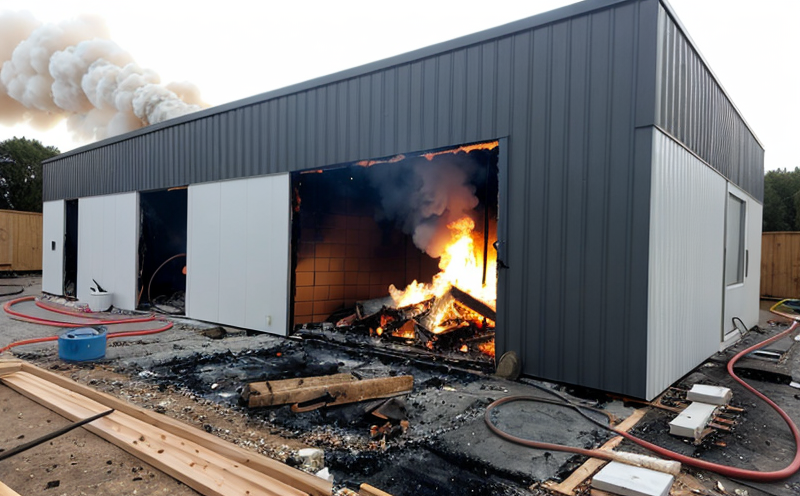Fire Endurance Testing of Insulated Metal Panels
In today’s fire safety landscape, the need to ensure that materials used in construction and infrastructure are safe under extreme conditions is paramount. Insulated metal panels (IMPs) play a crucial role in modern building designs due to their structural integrity, thermal performance, and aesthetic appeal. However, when these panels encounter a fire, it is essential to assess how they perform under the intense heat and flames that can spread rapidly within buildings.
Fire endurance testing of insulated metal panels is critical for verifying the fire resistance properties of these materials. This test evaluates the ability of IMPs to maintain their structural integrity and resist the spread of fire over time. The test follows internationally recognized standards such as ISO 834, EN 1363-2, ASTM E119, and others, ensuring that the results are consistent and reliable.
The testing process involves placing a sample IMP in a furnace where it is exposed to increasing temperatures over time. The test simulates real-world fire conditions, providing data on how long the panel can withstand exposure without collapsing or allowing flames to spread beyond the original area of contact with fire. This information is invaluable for architects, engineers, and construction professionals who need to ensure that their designs comply with local building codes and regulations.
Understanding the parameters involved in this test helps stakeholders make informed decisions. The specimen preparation includes ensuring that the sample is representative of actual IMPs used in construction projects. Instrumentation plays a crucial role here; high-temperature furnaces are used, along with thermocouples to monitor temperature changes accurately. Other equipment may include ventilation systems and fire resistance testers to ensure precise measurement.
The results from this testing provide critical insights into the performance of insulated metal panels under fire conditions. Compliance officers can use these findings to verify that products meet safety standards, while R&D engineers can refine their designs based on the data obtained. Quality managers have peace of mind knowing they are adhering to strict protocols and regulatory requirements.
Industry Applications: The demand for fire endurance testing of insulated metal panels is high across various sectors including commercial buildings, industrial facilities, and residential complexes. Below is a detailed look at some of the key applications:
- Commercial Buildings: Ensuring that IMPs used in office spaces, retail environments, and hotels comply with fire safety regulations.
- Industrial Facilities: Protecting manufacturing plants and warehouses from potential fires spreading rapidly through insulated panels.
- Residential Complexes: Providing assurance to homeowners and developers about the safety features of their buildings.
| Industry Sector | Application |
|---|---|
| Commercial Buildings | Verifying compliance with fire codes for IMPs used in non-combustible walls and ceilings. |
| Industrial Facilities | Evaluating the performance of IMPs against intense heat generated by industrial processes. |
| Residential Complexes | Testing the effectiveness of IMPs in preventing the spread of fire within homes and apartment buildings. |
| Application | Standard Compliance |
|---|---|
| Commercial Buildings | ISO 834, EN 1363-2, ASTM E119 |
| Industrial Facilities | ASTM E119, ISO 834 |
| Residential Complexes | EN 1363-2, ASTM E119 |
The test results are typically presented in a detailed report that outlines the performance of the IMP under fire conditions. This includes data on the time it takes for flames to spread beyond the initial point of contact, any structural changes observed during testing, and overall resistance to heat.
Why Choose This Test
Selecting fire endurance testing is a strategic decision that offers numerous benefits. Firstly, it ensures compliance with international standards such as ISO 834, EN 1363-2, ASTM E119, and others. Compliance is crucial for meeting legal requirements and ensuring the safety of occupants in buildings where IMPs are used.
Secondly, this test provides valuable data that can be used to improve product design. Engineers and architects can leverage the insights gained from these tests to enhance the performance of IMPs further. This iterative process helps in creating more resilient materials capable of withstanding harsh fire conditions.
Thirdly, choosing this testing ensures a robust quality assurance program. By conducting regular fire endurance tests, organizations demonstrate their commitment to safety and reliability. This not only enhances customer satisfaction but also builds trust among stakeholders.
The test is particularly beneficial for quality managers who need to ensure that all materials used meet stringent standards. For compliance officers, it offers a tool to verify adherence to regulations without compromising on performance. R&D engineers can use the results to innovate and develop new IMPs with improved fire resistance capabilities.
Customer Impact and Satisfaction
The impact of fire endurance testing extends beyond mere compliance; it significantly enhances customer satisfaction by ensuring that products meet or exceed expectations. Clients who invest in this type of testing can rest assured knowing that their IMPs are reliable and safe under extreme conditions.
For architects, the results from these tests provide confidence when specifying IMPs for projects. This leads to better-designed structures that not only comply with fire safety codes but also offer enhanced performance. Engineers benefit from having data-driven insights into material behavior during fires, allowing them to optimize designs and reduce risks associated with potential failures.
For builders and contractors, the use of IMPs that have undergone rigorous testing ensures a higher quality end product. This improves overall job satisfaction as they can deliver projects faster and more efficiently knowing the materials perform as expected.
Compliance officers see immediate benefits by avoiding legal issues related to non-compliant products. They also benefit from being able to demonstrate due diligence in choosing tested IMPs, thereby reducing liability risks.





